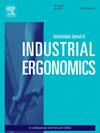The effectiveness of an ergonomics programme to reduce musculoskeletal disorders in high voltage overhead powerline workers
IF 3
2区 工程技术
Q2 ENGINEERING, INDUSTRIAL
International Journal of Industrial Ergonomics
Pub Date : 2025-10-08
DOI:10.1016/j.ergon.2025.103819
引用次数: 0
Abstract
High voltage overhead powerline work is physically demanding and exposes workers to a high risk of work-related musculoskeletal disorders (WRMSDs). This study investigated the effectiveness of interventions to reduce the risk of WRMSDs in powerline operators. Sixteen operators from Thailand who regularly used mobile elevating work platforms participated in the study. Following a task evaluation, an ergonomics improvement programme was implemented which involved engineering-design changes (e.g. purpose designed handling devices) and ergonomics training (e.g. techniques to reduce physically demanding postures). Pre- and post-intervention measures involved a musculoskeletal health survey, Rapid Entire Body Assessment (REBA) and the assessment of WRMSD risk levels (risk matrix). The ergonomics improvement programme led to changes in postures and working practices, and a reduction in WRMSD symptom reporting and WRMSD risk classifications when compared to pre-intervention measures. Following the intervention, musculoskeletal discomfort decreased by 25 % in the hands and wrists, 12.5 % in the shoulders, arms, and lower back, and 6.3 % in the neck, upper back, hips, knees, feet, and ankles. There was a significant shift to lower REBA scores and risk matrix classifications changed from high to medium risk. The implementation of engineering-designed changes combined with ergonomics training was effective in reducing the short-term risks associated with WRMSDs in high voltage overhead powerline workers. Further work is needed to determine the long-term effects of these interventions on the occupational health of powerline workers, along with strategies for addressing other risk factors (e.g. psychosocial, work organisation) known to impact on the incidence of WRMSDs.
减少高压架空电力线工人肌肉骨骼疾病的人体工程学方案的有效性
高压架空电力线工作对体力要求很高,并使工人面临与工作相关的肌肉骨骼疾病(WRMSDs)的高风险。本研究调查了降低电力线操作员wrmsd风险的干预措施的有效性。来自泰国的16名经常使用移动式升降工作平台的操作员参与了这项研究。在任务评估之后,实施了一项人体工程学改进计划,其中包括工程设计变更(例如,目的设计的搬运装置)和人体工程学培训(例如,减少对身体要求高的姿势的技术)。干预前和干预后的措施包括肌肉骨骼健康调查、快速全身评估(REBA)和WRMSD风险水平评估(风险矩阵)。与干预前措施相比,人体工程学改进方案导致姿势和工作方式的改变,减少了WRMSD症状报告和WRMSD风险分类。干预后,手部和手腕的肌肉骨骼不适减少了25%,肩部、手臂和下背部减少了12.5%,颈部、上背部、臀部、膝盖、脚和脚踝减少了6.3%。REBA评分显著降低,风险矩阵分类从高风险变为中度风险。工程设计变更的实施与人体工程学培训相结合,有效地降低了高压架空电力线工人与wrmsd相关的短期风险。需要进一步开展工作,以确定这些干预措施对电力线工人职业健康的长期影响,并制定战略,解决已知会影响wrmsd发病率的其他风险因素(如社会心理、工作组织)。
本文章由计算机程序翻译,如有差异,请以英文原文为准。
求助全文
约1分钟内获得全文
求助全文
来源期刊
CiteScore
6.40
自引率
12.90%
发文量
110
审稿时长
56 days
期刊介绍:
The journal publishes original contributions that add to our understanding of the role of humans in today systems and the interactions thereof with various system components. The journal typically covers the following areas: industrial and occupational ergonomics, design of systems, tools and equipment, human performance measurement and modeling, human productivity, humans in technologically complex systems, and safety. The focus of the articles includes basic theoretical advances, applications, case studies, new methodologies and procedures; and empirical studies.

 求助内容:
求助内容: 应助结果提醒方式:
应助结果提醒方式:


